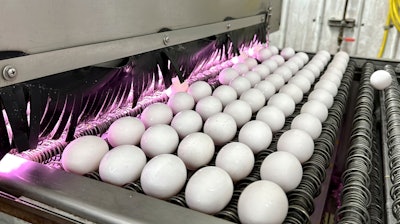
Egg prices are at near-historic highs in many parts of the world as the spring holidays approach, reflecting a market scrambled by disease, high demand and growing costs for farmers.
It's the second year in a row consumers have faced sticker shock ahead of Easter and Passover, both occasions in which eggs play prominent roles.
While global prices are lower than they were at this time last year, they remain elevated, said Nan-Dirk Mulder, a senior global specialist with Dutch financial firm RaboBank's RaboResearch Food and Agribusiness division. Mulder doesn't expect them to return to 2021 levels.
 A youngster collects Easter eggs during an egg hunt at the Bowling Green Ballpark, Bowling Green, Ky., April 8, 2023.Grace Ramey/Daily News via AP, File
A youngster collects Easter eggs during an egg hunt at the Bowling Green Ballpark, Bowling Green, Ky., April 8, 2023.Grace Ramey/Daily News via AP, File
In Europe, egg prices are 10% to 15% lower than last year but still about double what they were in 2021, Mulder said.
One major culprit is avian flu. Outbreaks of the deadly respiratory disease were reported in Europe, Africa and Asia in 2020 and spread to North America in 2021. In 2022 alone, more than 131 million poultry worldwide died or were culled on affected farms, according to the World Health Organization.
Outbreaks are continuing. In December, the U.S. confirmed cases in 45 commercial flocks and 33 backyard flocks, affecting 11.4 million birds, according to the U.S. Department of Agriculture.
In South Africa, egg prices soared after 40% of laying hens were killed late last year due to the respiratory disease, Mulder said. A tray of six eggs cost 25.48 South African rand ($1.34) last month, up 21% from February 2023.
Even when avian flu dissipates, it can take a long time for the egg market to settle. It takes a farm three to six months to replenish a flock, so during that time, egg supplies are lower and prices rise, said Emily Metz, president of the American Egg Board, a marketing organization.
If farms restock with too many chickens, it can drive prices down. That's what happened in the U.S. last summer when egg prices plunged to $2 per dozen.
"It's supply and demand searching out. You have to have a profitable price," David Anderson, a professor and extension economist for livestock and food marketing at Texas A&M University, said.
And profits can be hard for farmers to come by during periods of inflation. Chicken feed represents up to 70% of a farmer's costs, and feed prices doubled between 2020 and 2022, Mulder said. Weather, COVID-related disruptions and the war in Ukraine – which drove up the price of wheat and other crops -- were all contributors.
In Nigeria, the cost of a crate of eggs has doubled since the beginning of the year due to weakened currency, the removal of fuel subsidies and high costs for farmers.
Teslimat Abimbola, who runs a poultry farm in the southern city of Ibadan, said 25 kilograms of feed that cost 2,500 Nigerian naira ($1.78) in 2020 now costs 13,000 naira ($9.23). Abimbola has lost some customers as a result of price increases.
"Many farms have been forced to shut down due to the high costs of rearing chickens," Abimbola said.
The government of Lagos State, Nigeria's biggest economic center, has implemented a subsidy program to help consumers deal with the increased costs of eggs.
Elsewhere, government regulations play a part in lifting egg prices. Multiple states, including California and Massachusetts, have passed cage bans for egg-laying hens since 2018; this year, bans are set to take effect in Washington, Oregon and Michigan.
Converting to cage-free facilities is a big investment for farmers, and consumers may not always realize that's a factor in the higher prices they see at the grocery store, Metz said. She anticipates such conversion costs will eventually fall as more farms make the changeover.
Price peaks are inevitably followed by price drops, and egg prices will eventually settle into more normal patterns. In the short term, the holiday demand that picks up every Easter will ease heading into summer, Anderson said. Meanwhile, improving biosecurity measures should help blunt the impact of avian flu, he said.
Lyncoya Ilion, who teaches cooking classes and runs a catering business called Catered by Coya in Brown Deer, Wisconsin, says she's noticed egg prices inching back up over the last two to three months but hopes she won't have to pass her costs onto clients.
"I haven't had to increase prices yet because I'm anticipating that the egg prices will decrease again soon," Ilion said.
That's a good bet. In the U.S., egg prices are expected to decrease around 2.8% this year, according to the U.S. Department of Agriculture. That won't put them back to pre-COVID levels, but it should give some relief.
"People really love eggs, and they notice when that price fluctuates," Metz said. "Our farmers wish it wasn't such a sharp up and down as well. It makes everything challenging."






















